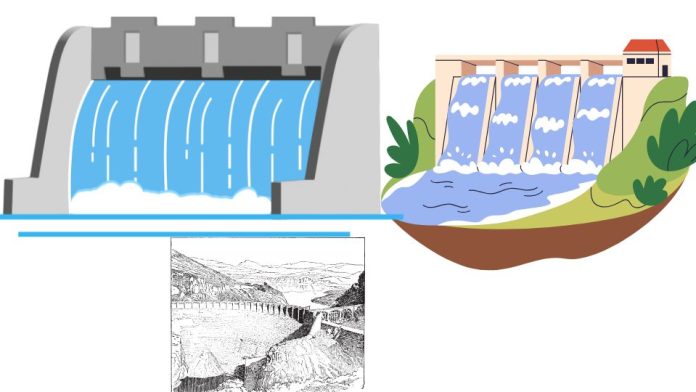The United States is home to numerous impressive dams, each notable for its size, capacity, and the vital roles they play in hydroelectric power generation, water storage, flood control, and irrigation. Here are ten of the most significant dams in the U.S.:
Hoover Dam
Located on the Colorado River at the border of Nevada and Arizona, Hoover Dam stands 726 feet tall and has a storage capacity of 30,237,000 acre-feet. Completed in 1935, it was a monumental engineering achievement of its time. The dam generates hydroelectric power and created Lake Mead, a crucial water reservoir for the southwestern United States.
Glen Canyon Dam
Situated in Arizona on the Colorado River, Glen Canyon Dam is 710 feet tall with a storage capacity of 29,875,000 acre-feet. Completed in 1966, it forms Lake Powell, the second-largest man-made reservoir in the U.S., providing water storage and hydroelectric power to the region.
Grand Coulee Dam
Located on the Columbia River in Washington State, Grand Coulee Dam stands 550 feet tall and has a storage capacity of 9,562,000 acre-feet. Completed in 1942, it is one of the largest concrete structures in the U.S. and a major hydroelectric power producer, significantly contributing to the Pacific Northwest’s energy supply.
Oroville Dam
Found on the Feather River in Northern California, Oroville Dam is the tallest dam in the U.S. at 770 feet, with a storage capacity of 3,540,000 acre-feet. Completed in 1968, it plays a crucial role in water supply, hydroelectric power generation, and flood control for the state.
Fort Peck Dam
Located on the Missouri River in northeastern Montana, Fort Peck Dam stands 250 feet tall and has a storage capacity of 18,700,000 acre-feet. Completed in 1940, it is one of the largest earthfill dams globally, providing flood control, hydroelectric power, and creating Fort Peck Lake, a significant recreational area.
Shasta Dam
Situated on the Sacramento River in Northern California, Shasta Dam is 602 feet tall with a storage capacity of 4,552,000 acre-feet. Completed in 1945, it forms Shasta Lake, the largest reservoir in California, essential for water storage, hydroelectric power, and flood control.
Garrison Dam
Located on the Missouri River in central North Dakota, Garrison Dam stands 210 feet tall and has a storage capacity of 23,800,000 acre-feet. Completed in 1953, it creates Lake Sakakawea, one of the largest man-made reservoirs in the U.S., providing flood control, hydroelectric power, and water storage for irrigation.
Dworshak Dam
Found on the North Fork Clearwater River in Idaho, Dworshak Dam is 717 feet tall. Completed in 1973, it is the third tallest dam in the U.S., providing hydroelectric power and flood control, and creating Dworshak Reservoir, a popular recreational area.
Theodore Roosevelt Dam
Situated on the Salt River near Phoenix, Arizona, Theodore Roosevelt Dam stands 357 feet tall. Completed in 1911, it was one of modern America’s earliest major dams, providing irrigation, flood control, and hydroelectric power, and creating Roosevelt Lake, the largest man-made lake in Arizona.
Bonneville Dam
Located on the Columbia River between Oregon and Washington, Bonneville Dam was completed in 1938. It plays a crucial role in hydroelectric power generation, navigation, and fish migration management, featuring locks and fish ladders to support local ecosystems.
These dams are not only engineering marvels but also play essential roles in their respective regions, contributing to energy production, water management, and recreation.


